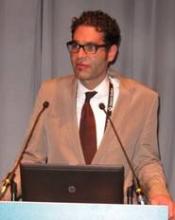For example, left ventricular ejection fraction rose from an average of 25% at baseline to an average of 31% 12 months after RD, compared with a 2% change in the control patients, a statistically significant difference, Dr. Táborský said.
In short, RD worked in normotensive patients with heart failure similar to a beta-blocker drug that cuts neurohormonal activation, commented Dr. José-Ramon Gonzalez-Juanatey, director of the cardiovascular department at the University Hospital of Santiago de Compostela in Spain. "This technique opens a new era in treating heart failure by decreasing sympathetic tone," he said.
In a similar vein, results reported at the meeting from another small, controlled study with 27 treatment-resistant hypertensive patients showed that by 6 months after RD, the treatment had significantly improved aortic augmentation index and aortic pulse-wave velocity, two markers of central vascular stiffness and central blood pressure. The average 1 m/sec improvement seen in aortic pulse-wave velocity 6 months after RD, reflecting a roughly 10% reduction in aortic stiffness, corresponds to about a10-year drop in the patients’ vascular age, said Klaas F. Franzen, a researcher at Schleswig-Holstein University Hospital in Lübeck, Germany.
"The idea is that by reducing whole-body sympathetic activity, you reduce vasoconstriction, and induce vasodilation in the renal arteries and central arteries," commented Dr. Felix Mahfoud, a cardiologist at Saarland University Hospital in Homburg, Germany.
The benefits from RD are not just cardiovascular. Another report at the meeting came from serial psychologic tests administered before and after 119 patients with drug-resistant hypertension underwent RD. In addition to producing an average drop in office blood pressure of 20/10 mm Hg, at both 3 and 6 months after treatment, RD also led to statistically and clinically significant drops in stress reaction, as measured on the Wiener Determination Task. In addition, among the roughly 20% of patients in the group of 119 who had clinically meaningful levels of anxiety or depression at baseline, RD also produced statistically and clinically significant falls in both anxiety and depression at both 3 and 6 months after treatment, reported Denise Fischer, Ph.D., a psychologist at Saarland University Hospital.
Another facet of her study looked at headache severity and found that at 3 and 6 months following RD all patients had statistically significant drops in headache intensity, and among the 20% of patients who entered the study with headaches self-rated as worse than 4 on a 0-10 visual analog scale, headache intensity fell from an average of about 8 before treatment to an average of less than 4 at 6 months after RD, Dr. Fischer said.


